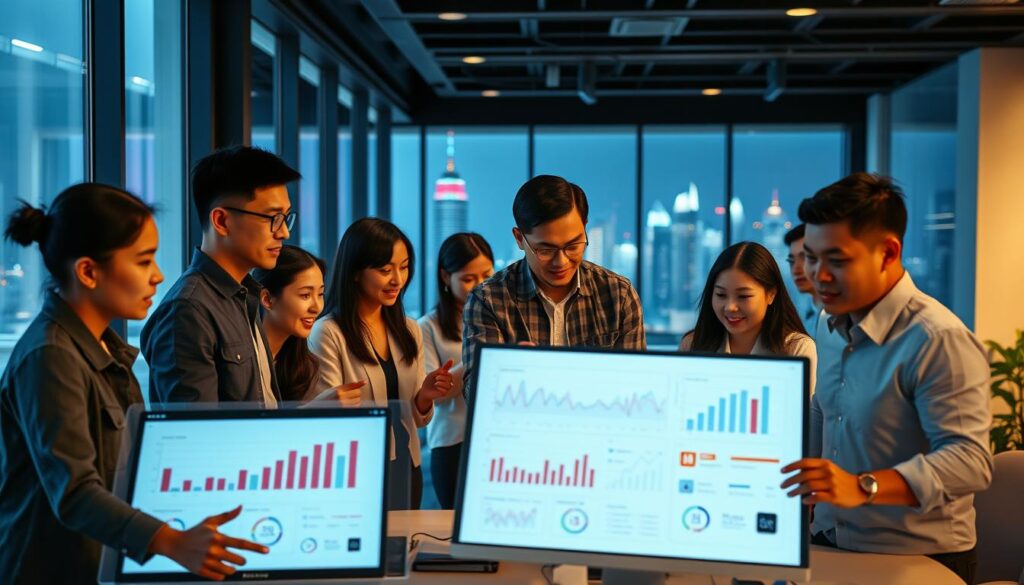Ever thought about how companies can really celebrate diverse talent? AI diversity tools are changing the game. They help make workplaces more inclusive. By using these tools in workforce planning, companies in the Philippines and Southeast Asia are finding new ways to hire fairly.
This article looks at how AI is changing diversity and inclusion in today’s job market.
Key Takeaways
- AI diversity tools are essential for enhancing workplace inclusion.
- Implementing inclusive workforce AI helps eliminate biases in hiring.
- Data-driven insights are crucial for effective workforce analytics & planning.
- A diverse workforce contributes to innovation and business success.
- Continuous improvement through AI leads to sustainable inclusivity.
- Ethical considerations must guide AI implementations in workforce diversity.
Introduction to AI and Workforce Diversity
Artificial Intelligence is changing how we work, focusing on diversity and inclusion. AI tools help companies improve hiring and make workplaces fairer. These tools help HR teams analyze data, making better choices and avoiding biases in hiring.
The Role of AI in Transforming Workforce Models
AI can look at huge amounts of data better than humans. This lets companies like Accenture judge candidates based on skills, not just what they look like. This way, companies meet their social goals and perform better by using diverse talent.
AI HR analytics for D&I help companies track diversity. They find groups that are not well-represented and work to improve.
Understanding Workforce Diversity in Today’s Context
Today, diversity in the workplace means considering race, gender, age, and experience. In the Philippines, it’s key to create an inclusive work environment. AI tools make hiring better, leading to happier employees and lower turnover.
Old hiring methods can be frustrating for job seekers. But, AI keeps candidates informed and interested, making the hiring process smoother.
Key AI Technologies Enhancing Diversity
Artificial Intelligence is key in making workplaces more diverse. It uses several technologies to fight biases and promote inclusivity. Machine Learning and Natural Language Processing are two main tools in this fight.
Machine Learning and its Applications
Machine learning is a strong tool for predictive analytics. It helps companies spot biases in their hiring. By looking at past data, it predicts trends and finds biases that might discriminate.
This approach helps improve hiring, making workplaces more diverse. It’s a step towards a fairer workplace.
Natural Language Processing for Bias Detection
Natural Language Processing (NLP) helps check job descriptions and reviews. It looks for biased words or phrases. This way, it helps companies avoid biases in their hiring.
Companies like Unilever use NLP to make their hiring better. This shows how AI can really help increase diversity in the workplace.

Importance of Inclusive Workforce AI
Using inclusive workforce AI is key to fair hiring and reducing biases. It helps companies find a more diverse group of candidates. With HR analytics for D&I, businesses can make sure everyone has a fair shot.
Creating Fair Hiring Practices
AI makes hiring fair by removing personal opinions. It focuses on what candidates can do, not who they are. This way, recruiters can avoid biases and make hiring fair for all.
Mitigating Unconscious Biases
Unconscious biases can make teams too similar. HR analytics for D&I helps spot these biases. AI looks at past hiring data to find and fix these issues. This makes teams more diverse and improves workplace culture.
Workforce Analytics & Planning: An AI Perspective
AI changes how companies plan their workforce. It gives insights into who works there, helping businesses in the Philippines focus on diversity. Advanced algorithms help spot trends, guiding important decisions.
AI helps plan resources better. It makes sure staff is used well, fixes diversity gaps, and boosts employee happiness. This leads to happier employees and less turnover.
AI also lets companies adjust their plans quickly. It’s key for keeping diversity efforts in line with business goals. In places like Southeast Asia, where workforces change fast, this is very helpful.

AI Applications in Recruitment Processes
AI diversity tools are changing how companies find talent. They help remove biases from old hiring ways. This leads to a more diverse and inclusive workplace.
Automated Resume Screening for Diverse Talent
AI systems scan resumes for skills and qualifications, not personal details. This opens up the talent pool to more diverse candidates. It also cuts down on biases, making hiring fairer for everyone.
Using AI for Unbiased Job Descriptions
AI helps write job ads without biased language. It checks the words used and suggests better ones. This makes job ads welcoming to all, helping companies find a more diverse team.
Performance Evaluation through AI
Performance evaluation is key to keeping employees engaged and the company thriving. AI diversity tools change how we assess people. They use facts, not just opinions, to judge performance.
Establishing Objective Performance Metrics
AI helps set clear goals for how well employees should do their jobs. It uses data to make sure everyone is judged fairly. This way, everyone knows what’s expected of them, making the workplace fairer.
Real-time Monitoring for Inclusivity
AI tools keep an eye on how well employees are doing, giving managers quick feedback. This helps spot and fix problems fast, making sure everyone feels included. It’s a way to make sure everyone feels valued and heard.

Continuous Learning and Development with AI
In today’s fast-changing work world, learning and growth are key. AI helps companies create learning experiences for diverse teams. This way, all employees can grow and improve their skills.
Personalized Learning Paths for Diverse Teams
AI tools make learning paths for each team member. This ensures training fits their skills and goals. It boosts engagement and helps employees from different backgrounds succeed.
This leads to a more skilled and diverse workforce. The company benefits from a team that reflects the community it serves.
Bridging Skill Gaps with AI Insights
AI helps find skill gaps and create programs to fill them. HR analytics for D&I are key in spotting areas for improvement. This way, employees can tackle challenges and work better together.
AI makes sure learning meets the company’s goals. It keeps learning inclusive and supports diversity.
Enhancing Employee Engagement through AI
Artificial intelligence is a powerful tool for boosting employee engagement. It analyzes huge amounts of data to understand team dynamics. This helps improve collaboration and respect among team members.
Data-Driven Insights for Team Dynamics
HR analytics for D&I help organizations see how engaged different teams are. They find out what’s affecting morale. This lets managers make changes to create a more inclusive culture.
Engaged employees are more productive and happy. They also tend to stay longer with the company.
Tools that measure engagement show patterns not seen before. For example, analyzing feedback can show what’s really going on in teams. This helps improve how teams work together.

Using data insights helps make sure everyone’s voice is heard. Regular checks on team interactions and feedback help build a culture of inclusivity. This makes the workplace a better place for everyone.
The work to improve engagement with AI never stops. Companies keep finding new ways to use AI to support diversity. For more on this, check out strategies for overcoming resistance to AI in team dynamics.
The Ethical Implications of AI in Workforce Diversity
As companies use AI diversity tools more, we must talk about the ethics. It’s important to make sure these tools help everyone. We need to avoid biases that can come from bad data.
Ensuring Fair Algorithms and Data Utilization
Creating fair algorithms is key to a diverse workforce. Companies should check their AI systems for biases. They should use diverse data to train AI, making sure it’s fair for everyone.
Maintaining Privacy and Transparency
Privacy and being open are vital for trust in AI. Employers must explain how they use data. This follows the law and respects privacy, making employees trust AI more.
Conclusion
In this article, we’ve seen how AI is key to improving diversity and inclusion in workforce planning. Companies in Southeast Asia can greatly benefit from using AI tools for diversity. These tools help spot and fix biases and boost employee happiness.
When AI and diversity goals align, businesses can celebrate differences and grow. AI helps keep up with the fast-changing global market. It also makes diversity a core value for companies.
More companies are seeing the value of a diverse team. Using AI solutions is crucial for this journey. AI is a big step towards a workplace where everyone feels valued and can fully contribute.

